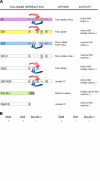Distinct intracellular motifs of Delta mediate its ubiquitylation and activation by Mindbomb1 and Neuralized
- PMID: 22162135
- PMCID: PMC3241720
- DOI: 10.1083/jcb.201105166
Distinct intracellular motifs of Delta mediate its ubiquitylation and activation by Mindbomb1 and Neuralized
Abstract
DSL proteins are transmembrane ligands of the Notch receptor. They associate with a RING (really interesting new gene) family E3 ubiquitin ligase, either Neuralized (Neur) or Mindbomb 1 (Mib1), as a prerequisite to signaling. Although Neur and Mib1 stimulate internalization of DSL ligands, it is not known how ubiquitylation contributes to signaling. We present a molecular dissection of the intracellular domain (ICD) of Drosophila melanogaster Delta (Dl), a prototype DSL protein. Using a cell-based assay, we detected ubiquitylation of Dl by both Neur and Mib1. The two enzymes use distinct docking sites and displayed different acceptor lysine preferences on the Dl ICD. We generated Dl variants that selectively perturb its interactions with Neur or Mib1 and analyzed their signaling activity in two in vivo contexts. We found an excellent correlation between the ability to undergo ubiquitylation and signaling. Therefore, ubiquitylation of the DSL ICD seems to be a necessary step in the activation of Notch.
Figures







Similar articles
-
The meaning of ubiquitylation of the DSL ligand Delta for the development of Drosophila.BMC Biol. 2023 Nov 16;21(1):260. doi: 10.1186/s12915-023-01759-z. BMC Biol. 2023. PMID: 37974242 Free PMC article.
-
Ubiquitylation-independent activation of Notch signalling by Delta.Elife. 2017 Sep 29;6:e27346. doi: 10.7554/eLife.27346. Elife. 2017. PMID: 28960177 Free PMC article.
-
Functional analysis of the NHR2 domain indicates that oligomerization of Neuralized regulates ubiquitination and endocytosis of Delta during Notch signaling.Mol Cell Biol. 2012 Dec;32(24):4933-45. doi: 10.1128/MCB.00711-12. Epub 2012 Oct 8. Mol Cell Biol. 2012. PMID: 23045391 Free PMC article.
-
Cell Polarity and Notch Signaling: Linked by the E3 Ubiquitin Ligase Neuralized?Bioessays. 2017 Nov;39(11). doi: 10.1002/bies.201700128. Epub 2017 Sep 21. Bioessays. 2017. PMID: 28940548 Review.
-
Notch ligand ubiquitylation: what is it good for?Dev Cell. 2011 Jul 19;21(1):134-44. doi: 10.1016/j.devcel.2011.06.006. Dev Cell. 2011. PMID: 21763614 Free PMC article. Review.
Cited by
-
A tail of two sites: a bipartite mechanism for recognition of notch ligands by mind bomb E3 ligases.Mol Cell. 2015 Mar 5;57(5):912-924. doi: 10.1016/j.molcel.2015.01.019. Mol Cell. 2015. PMID: 25747658 Free PMC article.
-
Functional Comparison between Endogenous and Synthetic Notch Systems.ACS Synth Biol. 2022 Oct 21;11(10):3343-3353. doi: 10.1021/acssynbio.2c00247. Epub 2022 Sep 15. ACS Synth Biol. 2022. PMID: 36107643 Free PMC article.
-
The role of targeted protein degradation in early neural development.Genesis. 2014 Apr;52(4):287-99. doi: 10.1002/dvg.22771. Epub 2014 Mar 27. Genesis. 2014. PMID: 24623518 Free PMC article. Review.
-
Cis-inhibition suppresses basal Notch signaling during sensory organ precursor selection.Proc Natl Acad Sci U S A. 2023 Jun 6;120(23):e2214535120. doi: 10.1073/pnas.2214535120. Epub 2023 May 30. Proc Natl Acad Sci U S A. 2023. PMID: 37252950 Free PMC article.
-
Spatio-Temporal Regulation of Notch Activation in Asymmetrically Dividing Sensory Organ Precursor Cells in Drosophila melanogaster Epithelium.Cells. 2024 Jun 30;13(13):1133. doi: 10.3390/cells13131133. Cells. 2024. PMID: 38994985 Free PMC article. Review.
References
-
- Banks S.M., Cho B., Eun S.H., Lee J.H., Windler S.L., Xie X., Bilder D., Fischer J.A. 2011. The functions of auxilin and Rab11 in Drosophila suggest that the fundamental role of ligand endocytosis in notch signaling cells is not recycling. PLoS ONE. 6:e18259 10.1371/journal.pone.0018259 - DOI - PMC - PubMed
Publication types
MeSH terms
Substances
LinkOut - more resources
Full Text Sources
Molecular Biology Databases

